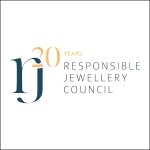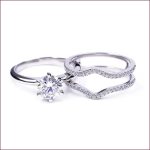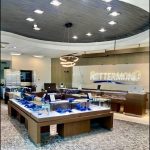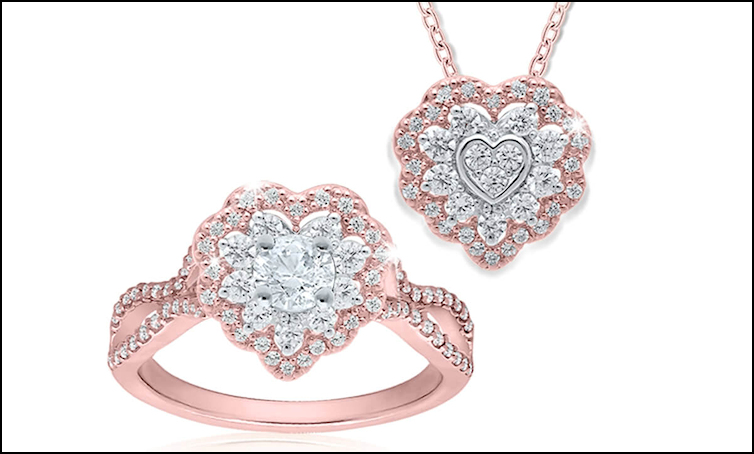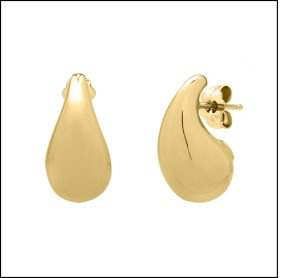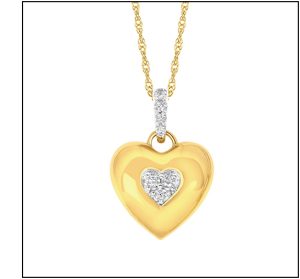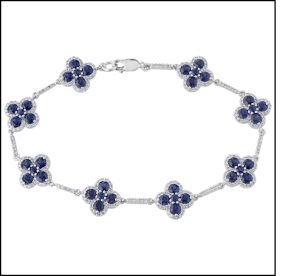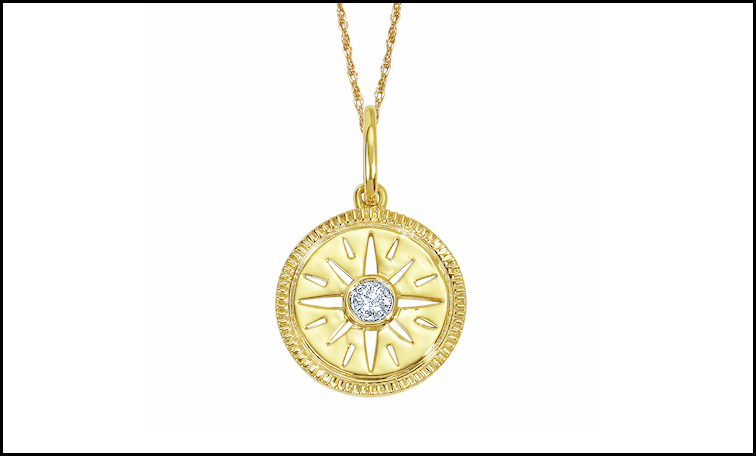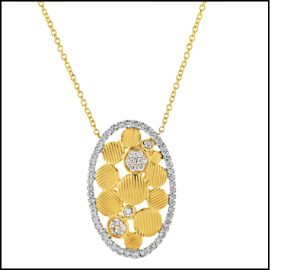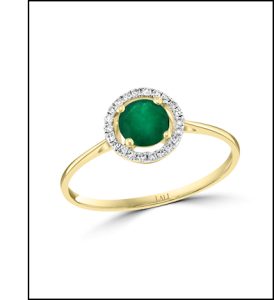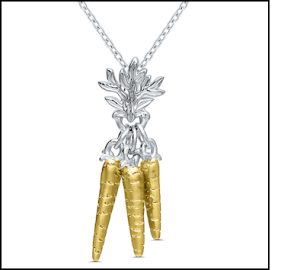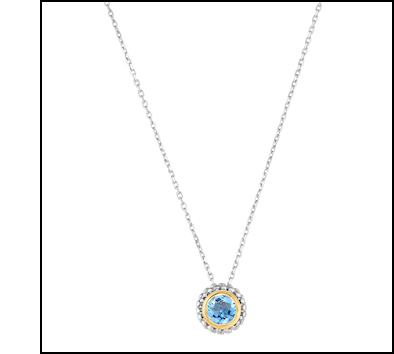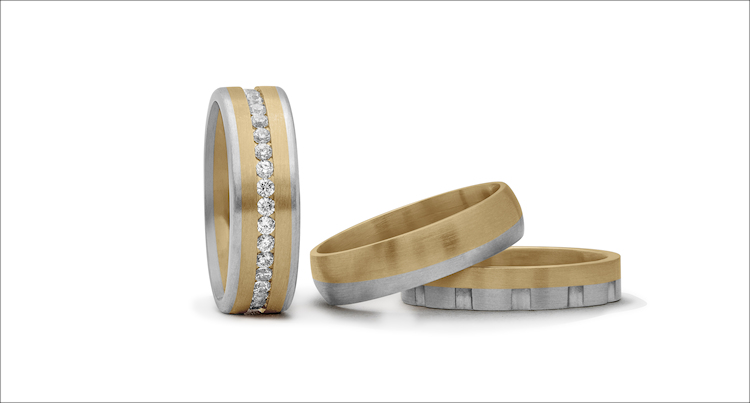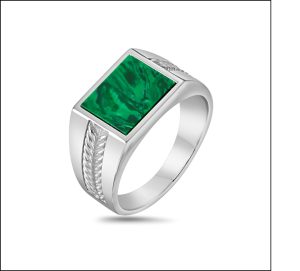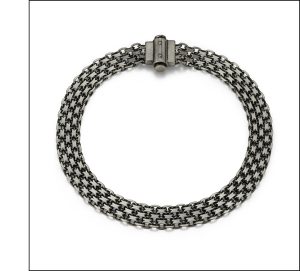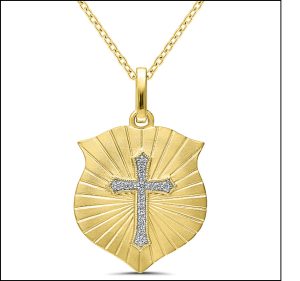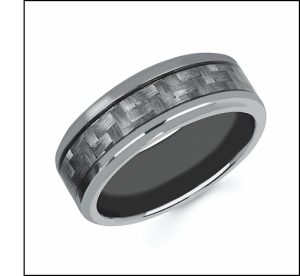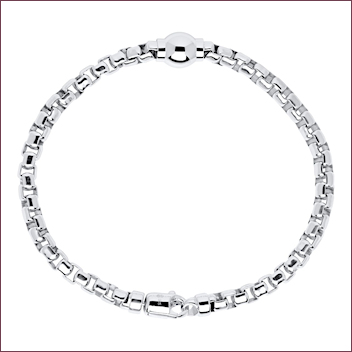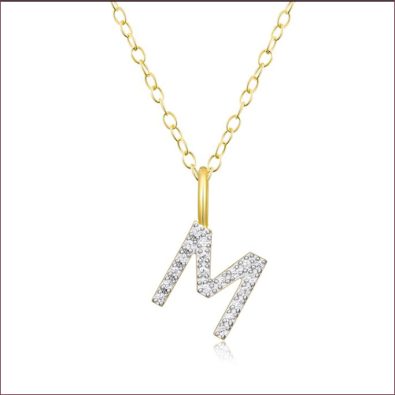Lights, Camera, Fashion!
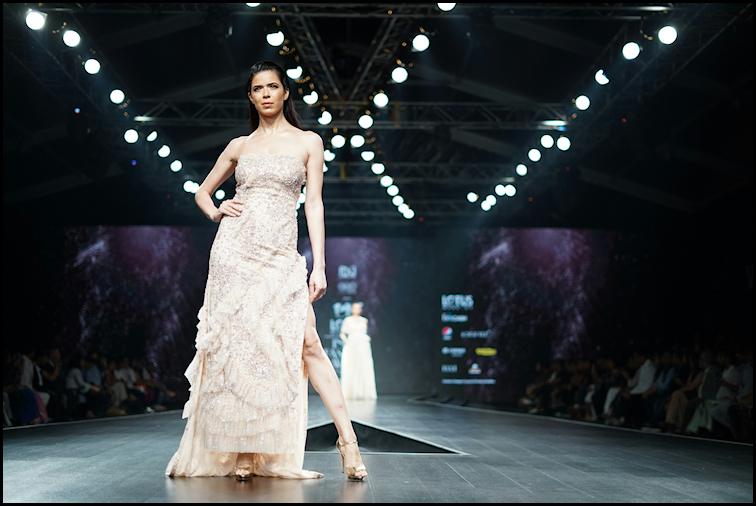
When fall hits, not only are the kids back in school but new couture and colorways make their way into the market, affecting inventory in jewelers’ cases. Merchants need to know how to position existing stock for sale against autumn hues and the latest necklines and sleeve lengths.
“Our biggest selling metal, yellow gold, is often paired with warm earth tones, and sometimes with brighter colors that have trended recently (like Pantone’s Color of the Year),” notes Phillip Gabriel Maroof, vice president of marketing and design, Royal Chain Group. “For white gold and silver metals, we pair them with black or cool tone colors.”
Ostbye, too, keeps that Pantone 2024 Color, Peach Fuzz, in mind for fall. After all, a palette of options, like morganite in pink gold, “could be trending for the year,” says Theresa Namie, merchandise manager.
And given that the popularity of men’s jewelry has been snowballing for several years, new product in that niche is as important now as women’s jewelry. Brands like Frederick Goldman and Royal Chain support merchants with training and marketing assets, something that all makers should provide.
And while many sales in store can be significant, entry-level prices are important not to overlook; retailers want to keep a steady stream of new clients walking through their doors. Innovation in the under $1,500 price point is ever important to do that.
Keep reading to learn how jewelry manufacturers are meeting retailers’ needs in these areas.
Fashion For All
Every September, four prominent international fashion weeks—New York, London, Paris, and Milan—drive some of the world’s most important fashion trends. The events provide a peek at the ready-to-wear that will hit stores six months later. Runway shows are important for jewelers because they reveal the clothing colors and silhouettes that store owners will be accessorizing by spring.
Savvy manufacturers know this and capitalize on the trends by calling attention to pieces in their lines—or creating new items—that reflect the hues and complement the couture. Fashion weeks are high-profile marketing opportunities.
Phillip Gabriel Maroof includes celebrity and runway shots in his campaigns whenever possible to drive home the point that designs from his Royal Chain Group are exciting and on trend.
“We try to include clothing trends and pair them with our products when we create our marketing campaigns,” explains the company’s vice president of marketing and design. “It gives some inspiration that retailers can use when targeting consumers.”
When the fashion weeks end, Goldstar Jewellery’s sales associate Caroline Lerche quickly gets to work putting together trend reports for her team. In particular, she aims to analyze and isolate the trends that are recurring and different but still have mass appeal, putting those in a presentation next to jewelry style ideas.
“It’s always helpful to see our marketing materials to gain knowledge on what is out there and what the public is seeing and saying about jewelry,” she says.
Her colleague Irene Yuh, sales director at the company, agrees and likes to share those reports with their retailers. While fashion’s color trends can directly relate to gemstones, color-blocking is another tool merchants can utilize—think of the color wheel and make appropriate suggestions.
“Clothing trends may help us sell jewelry only if the clothing material, pattern, or color tone are related to the story of the jewelry,” she notes.
Ostbye’s Theresa Namie always ties jewelry to fashion because “jewelry is fashion,” exclaims the merchandising manager. Social media is the ideal platform to share their ideas, posting fashion-theme Reels as soon as news is available so tie-ins to jewelry can be made.
More marketing assets like flyers and catalogs are shared by other firms. Shefi Diamonds supplies these to clients to emphasize key features that position its jewelry as “highly sellable,” observes Surbhi Jain, marketing director, Shefi Diamonds.
And it’s not just runways that provide fashion fodder—any high-profile event can be a source of inspiration. Besides fashion weeks, Namie’s favorites include the annual Met Gala and Oscars, but even the Olympics had its chic moments, including Snoop Dogg and Martha Stewart in full equestrian attire.
“Anything that people en masse will be watching is an opportunity,” she says. “Then we would do a ‘What did you like?’ or ‘What would you wear?’ scenario.”
ODI’s Valerie Fletcher agrees with leaning into all the pop culture events.
“Last year’s Barbiecore was great for our pink enamel and gemstones,” says the vice president of design and product development. “This summer’s ‘Brat Green’ works well with yellow gold, peridot, and smoky quartz.”
And while trends are fun and fine to take advantage of while they last, never underestimate the staying power of classics like blue. Shefi Diamonds’ Jain reveals that blue is the hue of their best-selling gemstones.
“It’s likely due to their versatility,” she maintains. “Blue complements nearly every fashion color trend, making it a popular choice among our customers. That timeless appeal ensures it remains in high demand.”
This Price Is Right
Call it an entry-level offering or a gift, fashion-forward new fine jewels priced up to $1,500 retail are always in demand! Clients in the market for a piece under this price point are typically looking at sterling silver or gold-plated silver items, some with 18k gold accents, or even minimalist styles in 14k gold with a dusting of diamonds or gemstone accents.
To appeal to these shoppers, Shefi Diamonds sells series of collections, such as its textured yellow gold and diamond designs, complete with displays. “This strategy not only showcases our designs effectively but also ensures a cohesive and attractive presentation for our customers,” explains Surbhi Jain, marketing director.
At the Royal Chain Group, pieces in this price point include stackable bracelets with mixed metals, while at Lali Jewelry, dainty gold and pearl styles are a good under-$1,500 option, as are birthstones, which are universally relatable.
“Everyone has one,” says PeriLynn Glasner, design and marketing director, Lali. “They make great gifts for a variety of occasions.”
At ODI, items under $1,500 can be made in karat gold. These include personalized pendants, studs, and small huggie hoops and inspirational numbers with messages of love, hope, and peace.
“The yellow gold and black diamond look is very popular, with some customers requesting faceted onyx in place of the black diamonds, to achieve a lower retail,” explains Valerie Fletcher, vice president of design and product development.
Ostbye is getting more requests for disk-style pendants, affordable gold earrings, and elevated silver designs. It has also had success with its 3-in-1 pendants featuring starburst or sunray motifs; double hoop and twist design earrings; floral, signet, and stacking rings; and silver bolo-style and bangle bracelets.
“We do make what our retailers ask for,” she observes.
In fact, it has a new upscale silver line called Sparkle Lane for those wanting “a more refined look without having to pay the gold price,” she adds.
Meanwhile, Caroline Lerche, sales associate, Goldstar Jewellery, says many of her clients are seeking out 10k gold, silver, and gold-plated designs “to hit the price point they need,” she says. “There has also been a big shift to lab-grown diamonds to hit lower price points.”
In lab-grown diamonds, small tennis-style bracelets and three-stone pendants and earrings are popular for Goldstar.
Fletcher is seeing a lot of requests for vermeil. Her firm’s mix features a “much thicker than normal flash … making it much more durable and less likely to tarnish over time,” she says.
As far as buyers’ ages, in general, the younger clients typically go for the trendy and less expensive, but that’s not always the case. Phillip Gabriel Maroof, vice president of marketing and design, Royal Chain, sees the newest generation buying pieces that could belong to their grandmother and grandmothers wanting the trendy. With so much crossover and so many ‘surprising sales’ happening at counters nationwide, he’s decided to be less focused on age during the design process.
“Styles can often transcend the intended target audience,” he says. “As a result, we’re less focused on segmenting our looks around age range these days.”
Boy’s Club
Perhaps no market has been more underserved in jewelry than men. Much to the relief of many a stylish guy, that has been changing due to market demand.
“Men’s jewelry is an evolving category with discerning customers,” says Phillip Gabriel Maroof, vice president of marketing and design, Royal Chain Group. “The man of today is looking for quality over quantity and is willing to invest more money to acquire it.”
Fellow manufacturer PeriLynn Glasner, design and marketing director, Lali Jewelry, sees the same shift in the market and is acting on it.
“We are coming out with men’s items all the time,” she says. “Men’s jewelry is becoming more on-trend as of late, so our retailers and trunk show events are having more male customers.”
Perhaps the most effective way to lure the men into jewelry stores is to appeal to their mates. This is what Sam Hupp, vice president of sales and marketing for Paris 1901, a division of Prime Art & Jewel, encourages stores to do.
“Men often gravitate towards the watch cases, so we recommend retailers place men’s jewelry nearby or at the checkout area,” he says. “Interestingly, the checkout area is also a spot where men tend to gather. We’ve heard many stories of female companions encouraging their male partners to ‘treat themselves’ while checking out, making it a shared and enjoyable experience.”
Styles that sell are all over the board. Inventory at Shefi Diamonds includes two-tone metal designs and onyx pieces crafted to appeal to seekers of both the traditional and contemporary. Royal Chain moves a lot of sterling silver with either Italian leather or black spinel and white sapphire for men, all items with average price points around $600 retail. New additions this spring included link bracelets and pendants with 18k yellow gold or black spinel accents.
Frederick Goldman, Inc., also uses black and blue sapphires to “reflect modern masculinity and sophistication,” says Tom Schwartz, vice president. The brand is known for using all metal types, but its new Fusion collection fuses platinum and gold and allows customers to customize their own rings.
Meanwhile, its Chroma collection of precious metal and colorful ceramic rings “pair perfectly with luxury watches,” notes Schwartz.
ODI offers textured, patterned, and satin or sandblasted finishes and laser-cut motifs as well as Cuban link bracelets in yellow gold or blackened silver. Most popular are the firm’s pendants with religious or heraldic symbols that have a “vintage feel,” says Valerie Fletcher, vice president of design and product development. More black jewels give a masculine vibe through black diamonds and black rhodium and black diamond tennis bracelets in plated silver.
Tantalum—a charcoal gray metal—is new for Ostbye and is “doing well,” according to Theresa Namie, merchandising manager. “Men like the look and feel of it,” she says.
Of course, there are always market surprises and serendipitous occasions, such as when many of the men admiring a new ladies’ signet ring line from Ostbye purchased pieces for themselves to wear on pinkies. “It was a nice twist!” says Namie.
As far as what’s driving guys into stores, celebrities can also help. Goldstar Jewellery’s sales associate Caroline Lerche observes what’s happening on red carpets to guide production.
“It allows us to create items that might be seen on celebrities, but translate them to mass retail,” she says.
The key to remember with trends at the high end is the interpretation for everyone else.
“Styles like those of Pharrell or Machine Gun Kelly often don’t match the price points or looks you’d find at your local independent jeweler,” maintains Hupp.
Let the styles, like layering chains, of those in the spotlight inspire manufacturers to make “more relatable and approachable” pieces, he urges.
Plus, it’s important to remember that the men’s jewelry market is evolving. According to Hupp, it’s becoming more gender neutral. This means that makers should introduce more modest sizes and create diverse marketing images. Doing so “demonstrates that your products are not only accessible in terms of pricing but also resonate with a broad spectrum of consumers,” he explains. “This approach not only broadens your market reach but also reinforces your brand’s commitment to diversity and inclusion.”
His brand’s answer to this unisex call? Its Ethos line of silver and gun-metal finishes with gemstones like agate and black sapphires that offer a subtle fashion flair—don’t look for dragon heads or skulls here. Understated elegance is the message Paris 1901 aims to deliver.
Finally, brand training helps all retailers move merchandise in stores. Training includes providing assets like social media posts, product information, images, displays, product photos, and talking points. Insights into male preferences and buying behaviors are also useful.
“All help retailers create an inviting and informative shopping experience,” says Schwartz.
